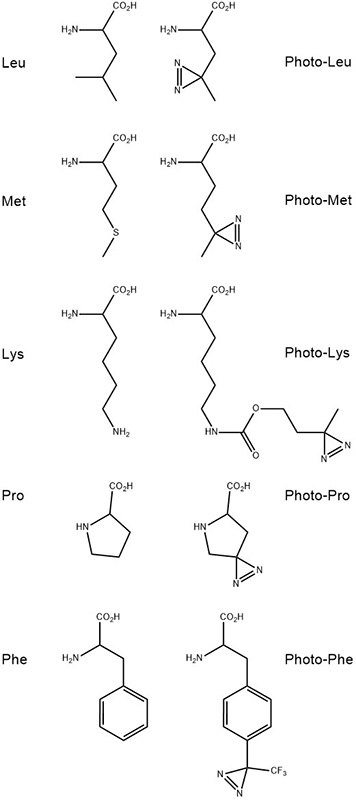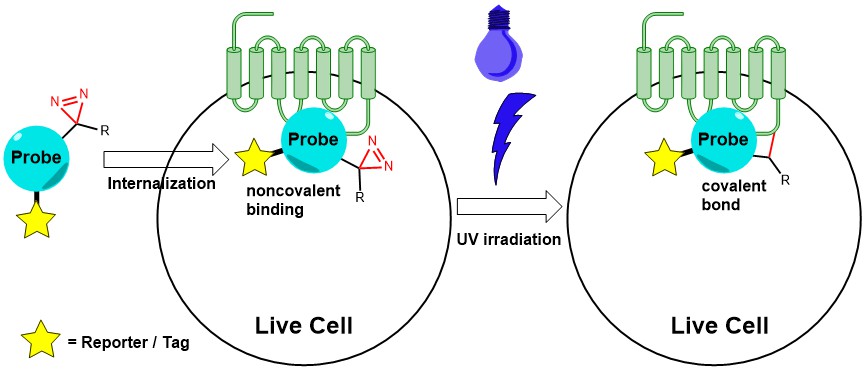Iris Biotech introduces a comprehensive set of photo-crosslinking amino acids bearing the diazirine moiety.
Irradiation of diazirines with UV light (ca. 350 nm - 360 nm) yields a highly reactive carbene species that can undergo insertions into C-C, C-H, O-H and X-H (X = heteroatom) bonds of neighboring molecules to irreversibly form a covalent bond. The diazirine moiety is the smallest of all photophores, so introduction of a diazirine-bearing amino acid into a peptide or protein usually does not impair its biological activity. Further advantages of diazirine crosslinkers are their stability at room temperature, as well as their relative stability to nucleophiles, and to both acidic and basic conditions.
Applications:
- Probing protein–protein and protein- peptide interactions by photo-crosslinking (e.g. site-specific incorporation of Photo-Lys into glutathione S-transferase allowing covalent crosslinking of the two subunits of the dimeric protein in E. coli)
- Probing protein- peptide interactions in order to identify cellular targets of peptides of interest
- Studying protein−drug interactions and identifying new drug targets
- By comparing results obtained from different proteomic setups (e.g. live cells and cell lysates), more putative targets can be identified.
These amino acids are available in Fmoc- as well as Boc-protected versions for their incorporation into synthetic peptides via standard coupling methods. Furthermore, the unprotected diazirine amino acids are also available for incorporation into expressed peptides and proteins by utilizing the appropriate aminoacyl-tRNA synthetase/tRNA pair. A combination of synthetic and recombinant approaches utilizing NCL has been demonstrated as well. Unnatural amino acids are frequently toxic to cells; however, these photo-amino acids are functional and nontoxic, which allows them to be a premium tool for studying mechanisms and interactions in living cells.


Identification of intracellular targets using a diazirine-bearing probe. By attaching a reporter group or tag to the probe, the target of the binding probe can be either identified using the reporter group, or isolated using the tag.
References:
- Protein-Polymer Conjugation via Ligand Affinity and Photoactivation of Glutathione S-Transferase; En-Wei Lin, Natalie Boehnke, and Heather D. Maynard; Bioconjugate Chem. 2014; 25: 1902-1909; dx.doi.org/10.1021/bc500380r.
- Cell-Based Proteome Profiling of Potential Dasatinib Targets by Use of Affinity-Based Probes; Haibin Shi, Chong-Jing Zhang, Grace Y. J. Chen, and Shao Q. Yao; J. Am. Chem. Soc. 2012; 134: 3001◊'2d3014; dx.doi.org/10.1021/ja208518u.
- Probing Protein-Protein Interactions with a Genetically Encoded Photocrosslinking Amino Acid; Hui-wang Ai, Weijun Shen, Amit Sagi, Peng R. Chen, and Peter G. Schultz; ChemBioChem 2011; 12: 1854 - 1857; DOI: 10.1002/cbic.201100194.
- Proteome profiling reveals potential cellular targets of staurosporine using a clickable cell-permeable probe; Haibin Shi, Xiamin Cheng, Siu Kwan Sze and Shao Q. Yao; Chem. Commun. 2011; 47: 11306-11308; DOI: 10.1039/c1cc14824a.
- Direct Interaction between an Allosteric Agonist Pepducin and the Chemokine Receptor CXCR4; Jay M. Janz, Yong Ren, Richard Looby, Manija A. Kazmi, Pallavi Sachdev, Amy Grunbeck, Lynn Haggis, Daniel Chinnapen, Amy Ying Lin, Christoph Seibert, Thomas McMurry, Kenneth E. Carlson, Tom W. Muir, Stephen Hunt III, and Thomas P. Sakmar; J. Am. Chem. Soc. 2011; 133: 15878-15881; dx.doi.org/10.1021/ja206661w.
- Aliphatic Diazirines as Photoaffinity Probes for Proteins: Recent Developments; J. Das; Chemical Reviews 2011; 111: 4405-4417. doi:10.1021/cr1002722
- Synthesis and application of photoproline - a photoactivatable derivative of proline; Benjamin Van der Meijden and John A. Robinson; ARKIVOC 2011 (vi) 130-136.
- Photo-crosslinking of proteins in intact cells reveals a dimeric structure of cyclooxygenase-2 and an inhibitor-sensitive oligomeric structure of microsomal prostaglandin E2 synthase-1; Pierre-Olivier Htu, Marc Ouellet, Jean-Pierre Falgueyret, Chidambaram Ramachandran, Joel Robichaud, Robert Zamboni, Denis Riendeau; Archives of Biochemistry and Biophysics 2008; 477: 155-162; DOI: 10.1016/j.abb.2008.04.038.
- Covalent Capture of Phospho-Dependent Protein Oligomerization by Site-Specific Incorporation of a Diazirine Photo-Cross-Linker; Miquel Vila-Perell, Matthew R. Pratt, Frej Tulin, and Tom W. Muir; J. Am. Chem. Soc. 2007; 129: 8068-8069; DOI: 10.1021/ja072013j.
- Photo-Leucine Incorporation Reveals the Target of a Cyclodepsipeptide Inhibitor of Cotranslational Translocation; Andrew L. MacKinnon, Jennifer L. Garrison, Ramanujan S. Hegde, and Jack Taunton; J. Am. Chem. Soc. 2007; 129: 14560-14561; DOI: 10.1021/ja076250y.
- Synthesis of Photoactive Analogues of a Cystine Knot Trypsin Inhibitor Protein; Thomas Durek, Junliang Zhang, Chuan He, and Stephen B.H. Kent; Org. Lett. 2007; 9(26): 5497-5500; DOI: 10.1021/ol702461z.
- Photo-leucine and photo-methionine allow identification of protein-protein interactions in living cells; Monika Suchanek, Anna Radzikowska, Christoph Thiele; Nature Methods 2005; 1-7; DOI: 10.1038/NMETH752.




